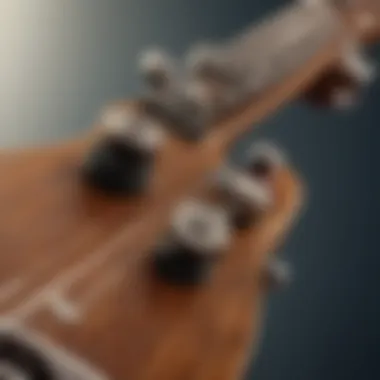Ultimate Guide to Tuning Your Ukulele Effectively


Intro
Tuning a ukulele is a crucial aspect of achieving resonant and pleasing sound. Unlike larger string instruments, like the guitar, the technique and tools used in tuning a ukulele may be less familiar. Understanding how to properly tune your ukulele not only enhances your performance but also extends the instrument's life. Proper tuning methods help to align with the pitch accurately, which is essential for playing chords or melodies. By grasping the different approaches to tuning, you embark on a journey that can enrich your musical experience significantly.
This guide is designed to give an in-depth exploration of various tuning methods as well as the tools that are essential in this practice. Attention will be paid to the significance of listening skills for tuning, recognizing common mistakes, and practical tips for maintaining your ukulele. Those who invest time learning these techniques can greatly improve their playing quality, ensuring hours of musical enjoyment.
Understanding Ukulele Tuning Basics
Ukulele tuning is the foundation of producing a pleasant sound from this instrument. Learning to tune properly achieves intonation, significantly enhances the overall playing experience. Notably, improper tuning affects harmony, the essence of music. Tuning serves not just technical but also emotional aspects. A well-tuned ukulele allows the player to focus on creativity and expression, thus encouraging better performance.
Importance of Tuning
The significance of tuning goes beyond just making the ukulele sound right. Here are some critical reasons why it matters:
- Musicality: Proper tuning contributes to the harmonious delivery of melodies.
- Playability: A ukulele that is in tune is much easier to play, allowing smoother transitions between chords.
- Feedback: Recognizing when to tune is an essential skill that helps one craft their ear for music.
- Instrument longevity: Regularly tuning helps identify underlying issues with strings or the instrument itself, preventing long-term damage.
Important Note: Tuning processes can differ among skills; some may find simpler methods easier, but understanding how to tune does play a significant role in one's musicianship.
Standard Tuning for Ukuleles
The standard tuning for a ukulele is G-C-E-A, where:
- G (the top string) is usually the one modeled as a high note, distinguishing it from guitar-type tuning where the lowest string bears the highest importance.
- C (second string) offers a darker tone functioning as the tonal anchor.
- E emphasizes notes typically found in lead parts, crucial for melody workers.
- A (bottom string) wraps up the order, tying the chord's webpage together.
Standard tuning creates a balanced sound, crucial for playing familiar songs. These notes contribute effectively across genres. Maintaining this standard is essential for most chords and songs.
In summary, the standard tuning forms the base of what successful players continuously return to, promoting learning and growth through disciplined practice. Ultimately, a well-tuned ukulele can create memorable music. In this highly engaging art, mastery over tuning equips players with the ability to explore various musical styles.
Types of Ukulele Tuning
Understanding the different types of ukulele tuning is essential for players seeking to expand their musical palette. The choice of tuning can significantly affect the sound and style of music. It also introduces various ways to interpret songs and creates unique musical identities. Knowing the types of tuning available allows ukulele players, from beginners to advanced musicians, to explore different sounds and enhance their musicality.
Standard Tuning
Standard tuning is considered the most common method for tuning a ukulele. In standard tuning, the four strings are tuned to G-C-E-A, from the top string down to the bottom string. This configuration not only serves as a foundation for playing multi-genre music but is also critical for effective collaboration with other musicians.
When a ukulele is in standard tuning, it produces a bright, cheerful sound. Many instructional materials and songbooks are built around this tuning. This fact makes standard tuning ideal for beginners who wish to learn chords and basic melodies without a steep learning curve. Additionally, because standard tuning is widely recognized, players can easily find resources and connect with other musicians on platforms like Reddit. To get started quickly, players might want to consider investing in an electronic tuner or a smartphone app for accuracy.
Key Benefits of Standard Tuning:
- Broad access to educational materials and chord charts
- Compatibility with most popular songs and exercises
- A forum system for players to engage with each other
Alternative Tunings


While standard tuning has its advantages, alternative tunings offer an appealing path for creative expression. Players may choose to explore tunings like re-entrant tuning, DGBE tuning, or even open tunings, depending on their preferred sound. Each style provides unique advantages.
Re-entrant tuning, for instance, retains the G string at a higher pitch compared to the series of low strings. This uniqueness can create distinct collaborations with other string instruments, offering something refreshing for played songs.
With tunings such as DGBE, musicians ease formulaic patterns in advanced progressions. This option often provides a fuller sound, which appeals to guitarists transitioning to the ukulele and adds a different timbre that offers a premium qualities.
When selecting alternative tunings, consider the following:
- What sound or emotion is desired?
- How compatible is the selected tuning with existing music?
- Is there a community or support for the chosen style?
Exploring alternative tunings ultimately elevates a musician's versatility and bolsters their confidence. It's a worthwhile venture for those interested in personal expression and pushing the types of music they create.
Manual Tuning Techniques
Tuning your ukulele manually is an invaluable skill that every player should develop. It allows for great flexibility, especially in different environments where electronic tuners may not be readily available. Manual techniques enhance your ear training and deepen your understanding of music. Familiarity with manual tuning methods also helps create a stronger bond with your instrument, leading to a more rewarding musical experience.
Using a Piano or Keyboard
One of the simplest methods for manual tuning involves using a piano or a keyboard. This approach aligns the ukulele's sound with a reference instrument, which is widely accessible. Each string on the ukulele corresponds to a specific note: G, C, E, and A in standard tuning. On a piano, you'll find these notes easily accessible.
- Identify the string notes: Start with the lowest string, the G string, and find its corresponding note on the piano. Once you have the correct G note, play it clearly.
- Tune the string: Pluck the G string on the ukulele while adjusting the tuner peg. Increase or decrease the tension until the pitch matches the note played on the piano.
- Repeat for other strings: Continue this process for the C string, E string, and finally the A string. For the C string, refer to the C note on the piano. Tune the E string by matching it to the E note. Lastly, similarly tune the A string to its piano counterpart.
This method not only helps ensure your strings are in tune, but it also aids in developing your -string ear. Over time, a player can develop the ability to accurately tune without additional instruments.
Using an App for Tuning
In the digital age, there are many useful applications available for tuning your ukulele. These apps combine convenience, accuracy, and ease of use. Many are compatible with smartphones and tablets, making them accessible on-the-go.
– One advantage of using an app is its visual simplicity. Most tuning apps display the pitch of the string you pluck, showing if you need to raise or lower the pitch.
– Compatibility is also noteworthy, as many tuning apps even allow players to select from different tunings, like standard or alternative setups.
To use an app effectively:
- Download a reputable tuning app: Search for popular options like GuitarTuna, Tunable, or PitchLab on your app store.
- Follow instructions: Open the app and follow the initial setup guide, which usually includes calibrating based on your device's speakers or microphone sensitivity.
- Tune your ukulele: Pluck each of your ukulele strings and adjust its tension according to the app's feedback.
Experts emphasize that apps can be particularly time-saving for beginners, providing instant feedback on tuning accuracy.
In summary, mastering manual tuning techniques such as using a piano or a tuning app is essential for aspiring ukulele players. Each method provides its unique advantages, whether you prefer the tactile interaction with a musical instrument or the convenience of technology.
Electronic Tuning Tools
Electronic tuning tools offer significant advantages for ukulele players seeking accuracy and efficiency. These devices facilitate the tuning process and can greatly enhance one's playing experience. For modern musicians, particularly in high-pressure performance settings, having precise tuning is crucial. Electronic tuners can help circumvent the complexities involved in traditional tuning methods, making tuning more straightforward and accessible, even for beginners.
Clip-On Tuners


Clip-on tuners have become quite popular among ukulele players due to their simplicity and convenience. These small devices attach directly to the headstock of your instrument. The main advantage is that they use vibration to gauge pitch, which means they can work effectively in various environments. External sounds won't affect the tuning process, allowing you to tune your ukulele accurately in a noisy setting, like during a jam session in a crowded place.
Additionally, clip-on tuners are usually quite affordable and are available in many diverse styles and colors. They typically feature a screen with clear visual indicators, showing how close your note is to the desired pitch. This kind of feedback allows you to make quick adjustments without spending too much time on the tuning process. However, it's vital to remember that not all clip-on tuners are equal; professional players may require devices with a high level of sensitivity to work on different string tensions effectively.
Pedal Tuners
Pedal tuners represent another category of electronic tuning tools that are particularly favored by performing artists and recording musicians. Unlike clip-on tuners, pedal tuners set a tone that caters to musicians with rig setups, such as electric ukulele players or those with longing desire for a depth in their tonal quality. These tuners are designed to be integrated into a pedalboard, which is often used with electric instruments.
One significant advantage of pedal tuners is that they typically provide a variety of tuning modes, enhancing flexibility for different setups. They establish a power outage state that ensures the tuner's functionality, regardless of what's happening in your playing environment. Similar to clip-on tuners, digital displays usually offer reliable accuracy and quick readouts for visual reassurances.
However, using a pedal tuner often requires extra equipment, like an amp and appropriate cables, which can increase setup time. But for musicians who thrive on precision and likely switch between multiple instruments, the accuracy of a pedal tuner can make it a worthy investment.
Note: No matter what electronic tuning tool you choose, having reliable gear is vital for getting the best sound out of your ukulele.
Steps for Tuning Your Ukulele
Tuning your ukulele is a fundamental skill that every player needs to cultivate. While it might seem trivial at first, proper tuning rewards you with an uplifted sound that significantly enhances your musical performance. When different notes blend harmoniously, the experience becomes unforgettable. Moreover, regular practice of tuning builds your ear for pitch, which makes it easier to learn new songs and grasp musical concepts. Consider these steps an essential ritual in your ukulele routine.
Step-by-Step Guide to Tuning
To begin, familiarize yourself with the standard tuning for ukuleles: G, C, E, A. The following guide outlines the steps to tune your ukulele using various methods.
- Identify Your Method: Choose between a manual or electronic method based on your preference. For beginners, an electronic tuner can simplify the process dramatically. Those with a musical background may prefer manual methods using a piano or their ear.
- Ensure Proper String Condition: Start with good quality strings. If your strings are worn out, replace them before tuning. New strings can change pitch as they stretch, so expect to retune frequently.
- Background Sound Check: If you are using manual tuning methods, be in a quiet environment. Ambient noise can confuse your pitch awareness.
- Tune the Highest String (A): Begin with the fourth string, A. Pluck it gently and tune it to the correct pitch. If using an electronic tuner, aim for the green light indicator. If using a manual method, find the reference note on the instrument of your choice.
- Tune Remaining Strings (C, E, G): Move to the third string (C), then the second string (E), and finally the first string (G). Make sure each string maintains open position tuning.
- Verify Every String: After finishing, pluck every string again, and ensure that they mesh well. An imbalance may suggest readjustment is required.
- Periodic Checks and Adjustments: Don't consider it finished. Regular checks during play are key to maintaining effective tuning, especially after extended use.
The process may at first appear tedious, but becoming attune to these steps instinctively enables clearer performances.
Listening Techniques
Listening is a vital component of the tuning process. While electronic tuners provide sounds and visuals to guide tuning, developing your aural skills is just as important. Here’s how you can enhance your listening ability while tuning:
- Compare with Known Tones: Establish a basis for pitch by comparing your ukulele strings with known fixed pitches. Tools like a piano, tone generator, or pre-recorded notes assist in refining each tuning experience.
- Develop Relative Pitch: Train yourself to listen for minor differences in pitch. Assess each string relative to the other strings. When done successfully, everything should resonate in harmony.
- Use Spectrum of Sound: Pay attention to how one string affects another when played together. Strumming two adjacent strings can reveal wayward pitches that may need adjustment.
- Listen for Overtones: As you pluck the strings, listen carefully. Well-tuned notes produce clearer overtones. Applying this understanding whilst tuning helps to ignore strings that may sound crowded or muddy.
- Frequent Experience: Tuning becomes easier the more you practice. Regular exposure and engagement with sounds burgeons your confidence and deepens your appreciation of musical subtleties.
Trying out these techniques can significantly bolster your skill in preparing your ukulele for impressive sounds.
Common Mistakes When Tuning
Tuning a ukulele is a delicate process. Many players overlook simple errors that can affect sound and playability. Understanding common mistakes when tuning ensures better sound quality and a more enjoyable playing experience. Recognizing these pitfalls can save time and frustration, allowing musicians to focus on honing their skills.
Over-tightening Strings
One of the major mistakes players make is over-tightening strings. Each string has its own tension limit. Exceeding this limit can lead to premature string breaking or even damage to the ukulele’s neck or body. Newer players often may tune using only their ear or through a tuner, but fail to notice they are going too far. This damages the instrument's integrity and leads to inconsistent sound.
It's very important to regularly check each string's tension. Use your tuner to monitor the pitch. Listen carefully when adjusting; quick changes can make it easy to overshoot the pitch and raise the tension too high.


Remember, tuning to the right pitch is essential. Violent pushes can break your precious instrument.
To avoid over-tightening:
- Start low: Tune the strings slightly below the desired pitch and gradually increase.
- Tune gently: Make small adjustments; this will let you hear each note distinctly.
- Check often: Consistently re-check before tackling more adjustments.
Ignoring String Stretch
Ignoring string stretch is another frequent error among players. When strings are new, they need some time to stabilize after being installed. When a new string is tuned for the first time, it will frequently go out of tune as it stretches.
If you do not stretch the strings preemptively, they may drop in pitch only a few minutes into play. This can be quite frustrating and negatively affects practice and performance.
To manage string stretch:
- Pull gently: After tuning, gently pull on the strings to aid the settling process.
- Re-tune regularly: After initial tuning, go back and check your pitch.
- Be patient: The strings will settle after a while. Let them stabilize before seeking return tuning.
Addressing these mistakes can enhance your ukulele playing. A little attention to detail will result in a more refined sound. Avoid these pitfalls to improve your overall musicianship.
Maintaining Tuning Stability
Tuning stability is a critical aspect of ukulele maintenance that warrants serious attention. The better the tuning stability, the more enjoyable your playing experience will be. A stable instrument stays in tune longer, reducing the hassle in adjustment during practice or performances. Several factors can affect tuning stability, such as string material, environment, and the player’s tuning habits. By understanding and implementing best practices, you can ensure that your ukulele stays in tune as you go along.
Regular Maintenance Routines
Regular maintenance routines can significantly enhance the tuning stability of your ukulele. Below are some recommended practices:
- Cleaning the strings: Dust and grime can accumulate on your strings affecting their performance over time. Make it a habbit to wipe them down after each session holds benefits.
- Changing Strings Periodically: Most players tend to overlook this, but strings lose elasticity over time. Regularly replacing them enhances performance and tuning accuracy. Recommended intervals depend on usage, but generally every couple of weeks works well for frequent players.
- Adjusting the Bridge: The bridge’s position can shift over time, affecting tuning stability. Periodically check the intonation and alignment to ensure the strings remain stable.
- Tune Before Playing: Consistently check your tuning before you start playing. This simple practice eliminates surprises as you progress through your music pieces. It's a small-time investment with potentially large payoffs.
The time spent on these routines will pay dividends in improved tone quality and a more enjoyable play experience.
Environmental Considerations
Environmental conditions can dramatically influence your ukulele’s ability to hold tuning. Factors such as temperature and humidity vary widely and can cause your instrument to expand or contract. Here are some key considerations that are relevant to maintaining stability:
- Humidity: Ukuleles are typically made from wood, which is sensitive to humidity changes. High humidity can cause wood to swell, while dry conditions can lead to shrinking. Therefore, maintaining a stable humidity level is crucial. Ideal room humidity fo wooden instruments is around 45–55%.
- Temperature: Should be consistent too. Fluctuations can affect wood warping or other materials utilized in the ukulele production. Prolonged exposure to extreme temperatures can lead to irreversible damage.
- Storage: When not in use, keep your ukulele in a protective case. This not only safeguards it against accidental falls and impacts but also creates a more stable micro-environment, insulating it from rapid changes in temperature or humidity.
“Regular care and the right environment go a long way to preserving your ukulele’s tone and tuning stability.”
By prioritizing these elements in your ukulele routine, you assure durability and overall happiness in your musical endeavors.
Finale: The Significance of Proper Ukulele Tuning
Tuning your ukulele is not merely a technical task. It brings forth some crucial benefits that define the quality of sound and performance. First and foremost, proper tuning enhances the overall tone of your instrument. A well-tuned ukulele produces clear and harmonious sounds that resonate beautifully. Hence, it becomes more enjoyable for both the player and the audience.
When a ukulele is out of tune, it contributes only to dissonance. Musicians will struggle both to play accurately and to convey emotion through their music. Therefore, the impact on one's ability to perform effectively simply cannot be overstated.
Another significant aspect involves the player’s connection with their instrument. Regular practice in tuning can actually improve one’s musical ear. Engaging with the outer edges of pitch heightens awareness of the subtleties in sound that an individual might overlook otherwise. This attentiveness often translates into better performance skills.
Additionally, there are external factors influencing the tuning of the ukulele. Environmental conditions such as temperature and humidity significantly affect the strings. Being attentive to these influences is vital for maintaining tuning stability.
Proper tuning fosters not just better sound but also a deeper connection between the player and the ukulele.







